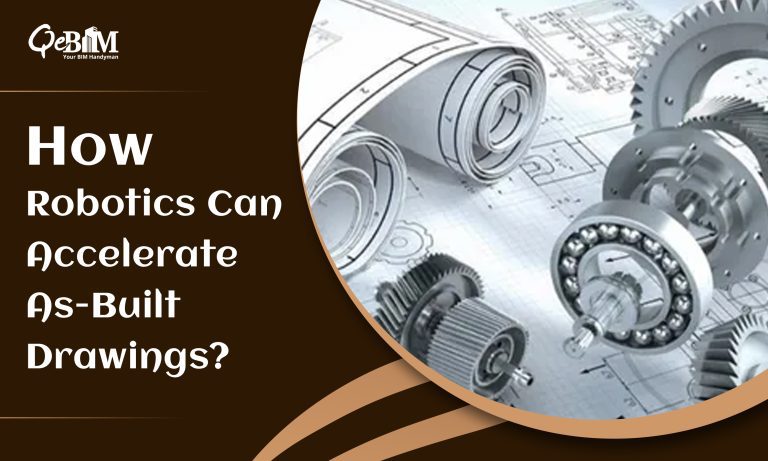How Robotics Can Accelerate As-Built Drawings?

Introduction
In the construction industry, accurate As-built Drawing Services are essential for ensuring that a project is completed successfully and meets all specifications. These drawings comprehensively illustrate the final structure, documenting any changes made during construction. However, creating as-built drawings can be a labor-intensive and prolonged process, often leading to delays and increased costs. In recent years, robotics has emerged as a potential solution to expedite the creation of as-built drawings. In this blog, we will gain insights into how robotics can help fast-track as-built drawings and its benefits to the construction industry.
The Challenges of As-Built Drawings
As-built drawings are the updated blueprints of a construction project, reflecting any deviations from the original plans that occurred during construction. These drawings are crucial for various reasons, including:
- Compliance: As-built drawings help ensure the final structure complies with building codes and regulations.
- Maintenance and Repairs: They provide valuable information for future maintenance and repair work, saving time and money in the long run.
- Documentation: As-built drawings serve as historical records of the construction process, aiding dispute resolution and liability issues.
Creating as-built drawings is traditionally a manual and time-consuming task. It involves surveying the construction site, measuring existing conditions, and then manually updating the original plans. This process can be error-prone, slow, and costly, especially for large and complex projects.
The Role of Robotics
Robotic technology has made significant strides during the last few years and is now being employed in various industries, including construction. Robotics can play a crucial role in fast-tracking the creation of as-built drawings through the following means:
1) Automated Site Surveys: Drones equipped with LiDAR (Light Detection and Ranging) sensors and cameras can be deployed to quickly and accurately survey the construction site. These drones can capture high-resolution images and 3D point cloud data, which can be used to create detailed site models.
2) Data Processing: Advanced software tools, often powered by artificial intelligence and machine learning, can rapidly process the data collected by drones. These tools can identify changes in the construction site, compare them to the original plans, and generate updated drawings automatically.
3) Precision Measurements: Robotic total stations and laser scanning devices can precisely measure existing structures and features. These measurements can be directly integrated into the as-built drawings.
Benefits of Robotic As-Built Drawing Creation
Implementing robotics in the creation of as-built drawings offers several benefits to the construction industry:
- Speed: Robotics can significantly reduce the time required to create as-built drawings. Automated site surveys, data processing, and precision measurements can be performed much faster than manual methods.
- Accuracy: Robots and AI-powered software tools can ensure high accuracy in the drawings. This minimizes the likelihood of errors and inconsistencies that can lead to costly revisions later.
- Cost Savings: Faster and more accurate drawing creation can save costs. Reduced labor costs and quicker project completion can translate into a more profitable construction process.
- Improved Documentation: Using robotics ensures that as-built drawings are comprehensive and up-to-date. This enhances the value of these drawings for future maintenance, renovations, and legal purposes.
- Enhanced Safety: Drones and robotic devices can access difficult or hazardous areas of a construction site, reducing the need for workers to be exposed to potential dangers.
- Real-Time Updates: With the help of robotics, as-built drawings can be updated in real-time as construction progresses, providing project managers with instant insights into the project’s status.
Challenges and Considerations
While the integration of robotics in as-built drawing creation offers many advantages but there are several challenges and factors that require attention and resolution:
- Initial Investment: Implementing robotics requires an initial investment in technology and training. Companies must weigh this cost against the potential long-term benefits.
- Data Security: The data collected by drones and robotic devices must be protected to prevent unauthorized access and potential security breaches.
- Regulatory Compliance: The use of drones and robotics in construction may be subject to specific regulations and permits, depending on the location and type of project.
- Integration: Integrating robotic technology into current construction procedures and workflows may necessitate modifications and training for the workforce.
- Maintenance: Robotics systems require regular maintenance and calibration to ensure accuracy and reliability.
Speeding Up As-Built Drawings with Robotics: A New Era
As-built drawings are vital for the successful completion of construction projects, and the traditional manual methods of creating them can be time-consuming and error-prone. Robotics offers a promising solution to fast-track the creation of as-built drawings, providing benefits such as speed, accuracy, cost savings, and enhanced documentation. Though there are challenges and considerations to address, the potential advantages make the integration of robotics into the construction industry a compelling prospect. As technology advances, we expect to see greater adoption of robotics in construction, ultimately improving project efficiency and outcomes.